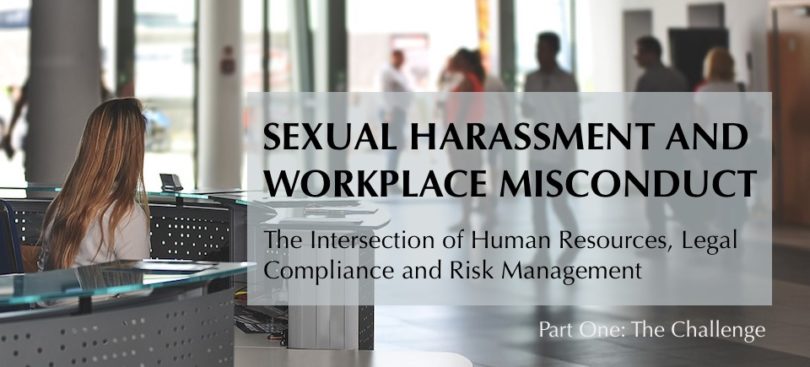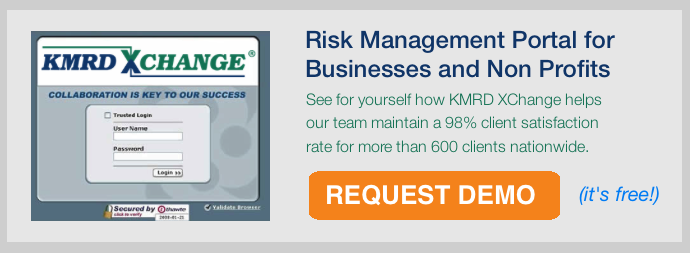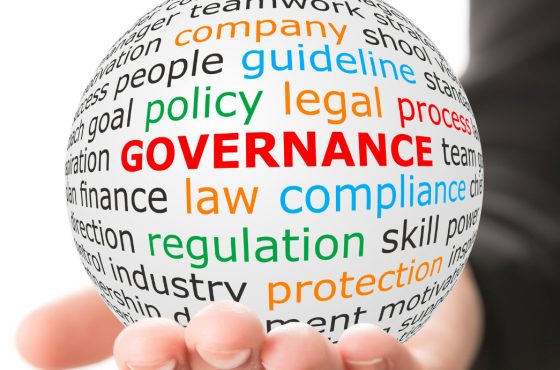Sexual Harassment and Workplace Misconduct: The Intersection of Human Resources, Legal Compliance and Risk Management (Part One)
By John E. Garber, Jr., SPHR, SHRM-SCP and Christin Smith Myers
Part One: The Challenge
What is going on?
News surrounding Matt Lauer, Bill O’Reilly, Charlie Rose, Al Franken, Kevin Spacey, and Harvey Weinstein and many others should be prompting organizations to examine their sexual harassment policies, procedures and more importantly, their organizational culture.
It has become part of the weekly news cycle to hear about harassment allegations against sports figures, entertainers and corporate executives. However, this is not just an issue isolated to high profile individuals. Two particular cases come to mind which may not be widely known. In 2012 Ani Chopourian, a California nurse, prevailed in a significant case against the Sacramento hospital where she worked. She filed multiple complaints over a two-year period and did not get any employer support. The jury awarded Chopourian $168 million. Ashley Alford, an employee at a rent-to- own furniture store settled a $95 million suit in a 2011 EEOC case. She made repeated complaints and the company did very little to intervene and resolve the problem. Unfortunately, thousands of similar cases are filed annually.
Fear of retaliation is usually the reason many do not file complaints.
Harassment is far too prevalent. A 2016 EEOC Select Task Force study suggests one in four employees experiences sexual harassment. There is a pattern; in many cases, behavior was pervasive and occurring for years. Complaints were reported and nothing was done to stop the behavior. Fear of retaliation is usually the reason many do not file complaints. And when complaints are filed victims recount a lack of support and follow through by their organizations. Most organizations have policies against sexual harassment, including training, but they are not upholding their own policies.
Let KMRD review your policies and procedures related to sexual harassment and misconduct. Contact KMRD →
The core issues go beyond company policy and revolve around morality, power, code of conduct and governance. Of course, most organizations genuinely do not want sexual harassment and workplace misconduct to exist. But in the 20 years since two landmark US Supreme Court Decisions concerning sexual harassment it seems like employers are merely “checking the box.” When organizations fail to address sexual harassment and the underlying behavior through a zero-tolerance approach, it becomes a silent permission for the behavior to continue.
Sexual Harassment and Workplace Misconduct:
Pursuant to the U.S. Equal Opportunity Commission (EEOC), sexual harassment is a form of sex discrimination violating Title VII of the Civil Rights Act of 1964. Employers with 15 or more employees are subject to Title VII, which prohibits “unwelcomed sexual advances, requests for sexual behaviors, and other verbal or physical conduct of a sexual nature when the conduct explicitly or implicitly affects an individual’s employment, unreasonably interferes with an individual’s work performance, or creates an intimidating, hostile, or offensive work environment.”
There are two types of sexual harassment – Quid Pro Quo and hostile work environment. Two 1998 US Supreme Court rulings, Faragher v. City of Boca Raton and Burlington Industries, Inc. v. Ellerth (see Faragher-Ellerth Defense), established the basis for organizations to develop and implement sexual harassment policies and training. Following the Court’s rulings, an employer must demonstrate that it exercised reasonable care to prevent and promptly correct the harassing behavior. In order to accomplish this requirement, an employer must have a complaint procedure and promptly investigate allegations of harassment.
Not only does an employer need to establish a procedure, it must be clearly communicated to employees. If employees do not avail themselves of the reporting process it could serve as a basis for the employer to assert an affirmative defense. When employees take advantage of reporting complaints, the investigation process becomes an essential element of understanding the facts of the complaint and to reasonably determine if the allegations are substantiated. At the conclusion of the investigation, the employer needs to assess the gravity of the behavior and take appropriate corrective action, which may include counseling, suspension or termination of the harasser.
Let KMRD develop a sexual harassment compliance training program for you that actually works. Contact KMRD →
Today, most allegations of sexual harassment are going to be examined on the basis of whether or not any tangible employment action has been taken against the victim. The Supreme Court defined tangible employment action in the two aforementioned cases as “a significant change in employment status, such as hiring, firing, failing to promote, reassignment with significantly different responsibilities, or a decision causing a significant change in benefits.” For example, Joe, a Division Manager makes sexual advances on Brenda, one of Joe’s employees. Brenda rejects the advances and as a result, Joe reassigns her to another position with lower pay and no benefits. Joe has just taken tangible employment action on Brenda.
This is an important issue for organizations to understand. When tangible action is taken an employer is strictly liable. Consequently, in addition to having policies and procedures, formalized training must be provided to all employees with additional training for supervisors and managers. The additional training for supervisors and managers should include:
- How to objectively discuss complaints;
- The process for communicating complaints to human resources;
- Communicating the fact that confidentiality cannot be guaranteed but privacy will be respected as much as possible;
- Prohibiting retaliation;
- Conflict resolution; and
- Proper use of positional authority
While Title VII is applicable to employers with 15 or more employees, smaller employers are not immune from addressing sexual harassment. State and local laws usually afford additional protections beyond the federal definition (e.g. California). And, most state and local laws are applicable to employers with 15 or fewer employees.
Even though the majority of sexual harassment and hostile work environment claims are against men, anyone can be sexually harassed. Harassment involving sex and harassment based on sexual orientation is becoming increasingly blurred. Men and women are protected under Title VII for harassment associated with gender-based stereotypes. Sexual harassment is a gender-neutral offense and employers should be mindful of making assumptions concerning victims of sexual harassment.
Workplace misconduct is generally considered unacceptable behavior which is unprofessional and undermines a positive work culture. Examples include use of profanity, physically touching another employee, fraternizing in the workplace, insubordination, being under the influence of alcohol or drugs, and stealing. Gross misconduct is grounded in employment law and involves, for example, violating EEOC laws.
Employers have a legal obligation to prevent sexual harassment and workplace misconduct. There are also serious business considerations. Harassment and misconduct have a hugely negative effect on morale, productivity, profitability and an organization’s reputation. Employees who are experiencing harassment are less engaged than their co-workers, and those who witness unaddressed harassment also develop a dimmer view of their employer. This contributes to low engagement and increased turnover. Both of these greatly impact an organization’s productivity and profitability. And the reputational risk for an organization is significant; customers want to do business with brands they trust.
In our next post we suggest a best practices framework to be adopted.
Read Developing and Implementing an Effective Approach (Part Two)
Contact us below to have KMRD set up or review sexual harassment policies and procedures for your business.

John Garber is Managing Director and Practice Leader at KMRD Partners, Inc., an award winning risk management and human capital solutions firm.

Christin Smith Myers is Chief Operating Officer at Combined Resource Solutions, an Exton, PA-based consulting firm.
Contact UsHuman Capital Solutions About KMRD
Note: This content is provided as general background information and should not be taken as legal advice or financial advice for your particular situation. Make sure to get individual advice on your case from a KMRD risk professional before taking any action.






